Corporate Finance: Funding Sources and Entity Classifications
VerifiedAdded on 2022/10/09
|19
|4040
|34
Report
AI Summary
This report analyzes the corporate financial accounting practices of Wesfarmers and Woolworths Group, focusing on their equity and liabilities over a three-year period. It examines the movement in equity components like capital equity, reserves, and retained earnings, highlighting significant changes such as the decrease in Wesfarmers' equity due to demerger capital distribution. The report assesses the liabilities sections, detailing the fluctuations in current and non-current liabilities, including the impact of asset sales and borrowings. Furthermore, it provides a comparative analysis of the advantages and disadvantages of equity and debt financing for both companies. Finally, the report discusses the concepts of large and small proprietary companies and reporting entities, outlining their classification implications and reporting requirements.

CORPORATE FINANCIAL ACCOUNTING
Paraphrase This Document
Need a fresh take? Get an instant paraphrase of this document with our AI Paraphraser
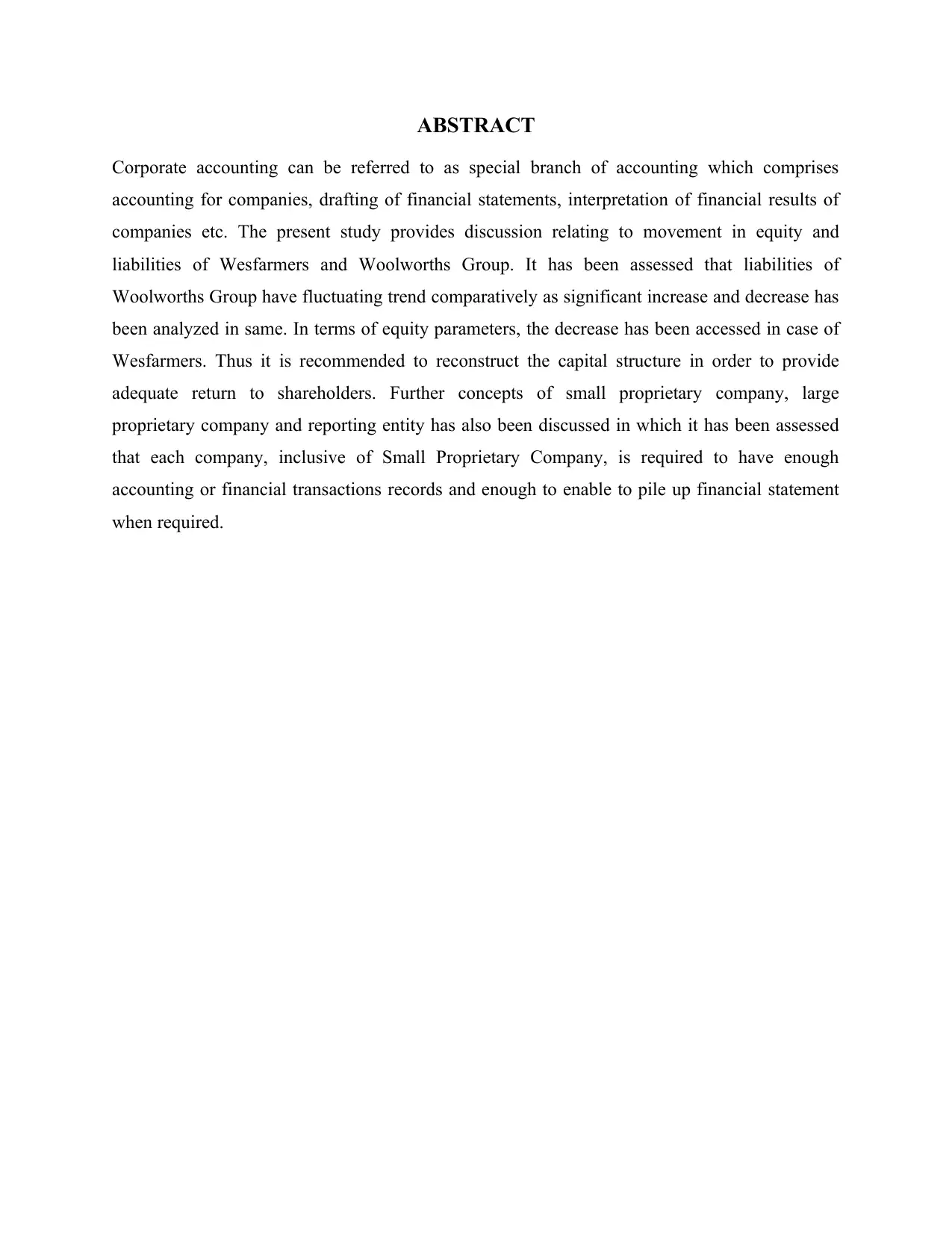
ABSTRACT
Corporate accounting can be referred to as special branch of accounting which comprises
accounting for companies, drafting of financial statements, interpretation of financial results of
companies etc. The present study provides discussion relating to movement in equity and
liabilities of Wesfarmers and Woolworths Group. It has been assessed that liabilities of
Woolworths Group have fluctuating trend comparatively as significant increase and decrease has
been analyzed in same. In terms of equity parameters, the decrease has been accessed in case of
Wesfarmers. Thus it is recommended to reconstruct the capital structure in order to provide
adequate return to shareholders. Further concepts of small proprietary company, large
proprietary company and reporting entity has also been discussed in which it has been assessed
that each company, inclusive of Small Proprietary Company, is required to have enough
accounting or financial transactions records and enough to enable to pile up financial statement
when required.
Corporate accounting can be referred to as special branch of accounting which comprises
accounting for companies, drafting of financial statements, interpretation of financial results of
companies etc. The present study provides discussion relating to movement in equity and
liabilities of Wesfarmers and Woolworths Group. It has been assessed that liabilities of
Woolworths Group have fluctuating trend comparatively as significant increase and decrease has
been analyzed in same. In terms of equity parameters, the decrease has been accessed in case of
Wesfarmers. Thus it is recommended to reconstruct the capital structure in order to provide
adequate return to shareholders. Further concepts of small proprietary company, large
proprietary company and reporting entity has also been discussed in which it has been assessed
that each company, inclusive of Small Proprietary Company, is required to have enough
accounting or financial transactions records and enough to enable to pile up financial statement
when required.
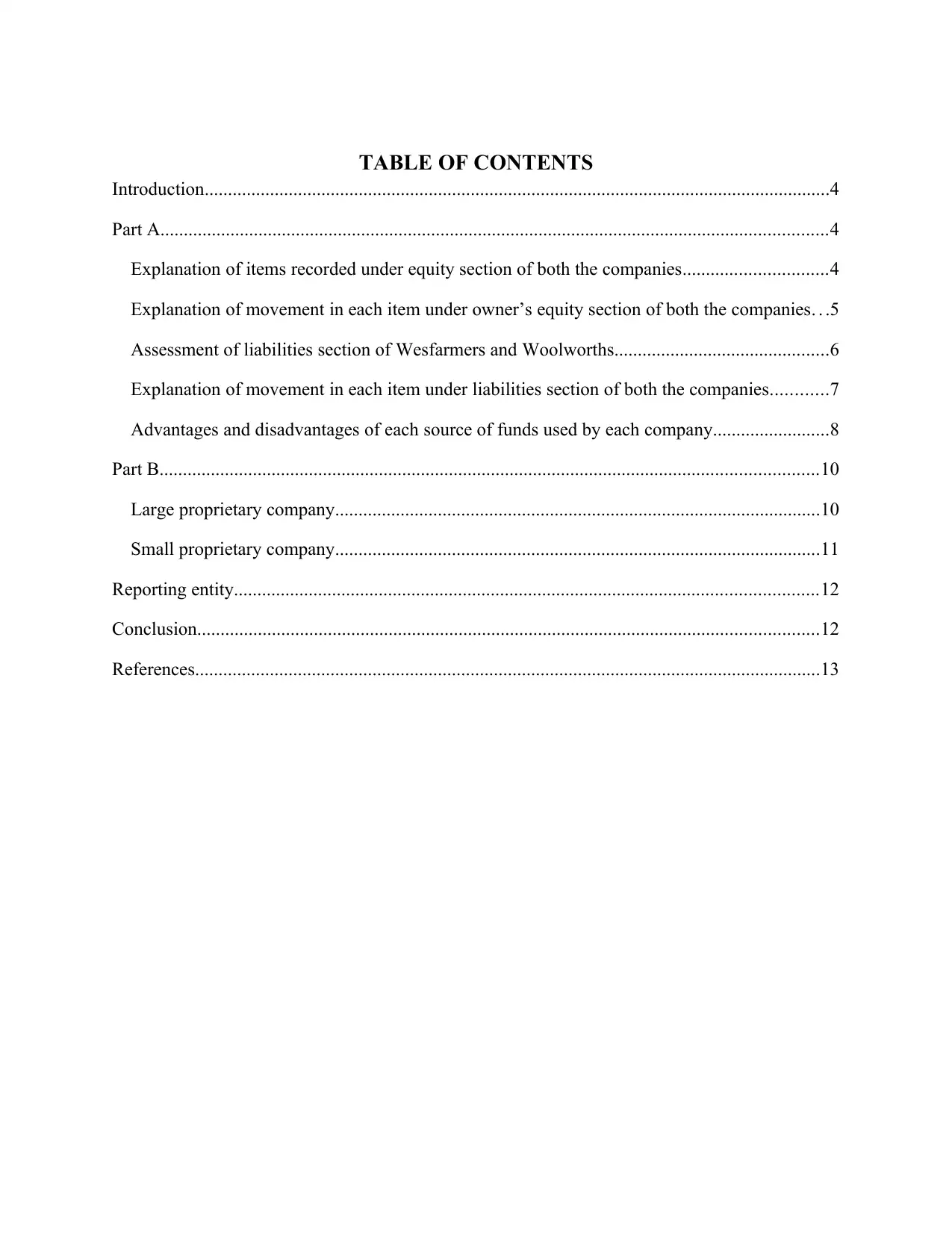
TABLE OF CONTENTS
Introduction......................................................................................................................................4
Part A...............................................................................................................................................4
Explanation of items recorded under equity section of both the companies...............................4
Explanation of movement in each item under owner’s equity section of both the companies. . .5
Assessment of liabilities section of Wesfarmers and Woolworths..............................................6
Explanation of movement in each item under liabilities section of both the companies............7
Advantages and disadvantages of each source of funds used by each company.........................8
Part B.............................................................................................................................................10
Large proprietary company........................................................................................................10
Small proprietary company........................................................................................................11
Reporting entity.............................................................................................................................12
Conclusion.....................................................................................................................................12
References......................................................................................................................................13
Introduction......................................................................................................................................4
Part A...............................................................................................................................................4
Explanation of items recorded under equity section of both the companies...............................4
Explanation of movement in each item under owner’s equity section of both the companies. . .5
Assessment of liabilities section of Wesfarmers and Woolworths..............................................6
Explanation of movement in each item under liabilities section of both the companies............7
Advantages and disadvantages of each source of funds used by each company.........................8
Part B.............................................................................................................................................10
Large proprietary company........................................................................................................10
Small proprietary company........................................................................................................11
Reporting entity.............................................................................................................................12
Conclusion.....................................................................................................................................12
References......................................................................................................................................13
⊘ This is a preview!⊘
Do you want full access?
Subscribe today to unlock all pages.

Trusted by 1+ million students worldwide
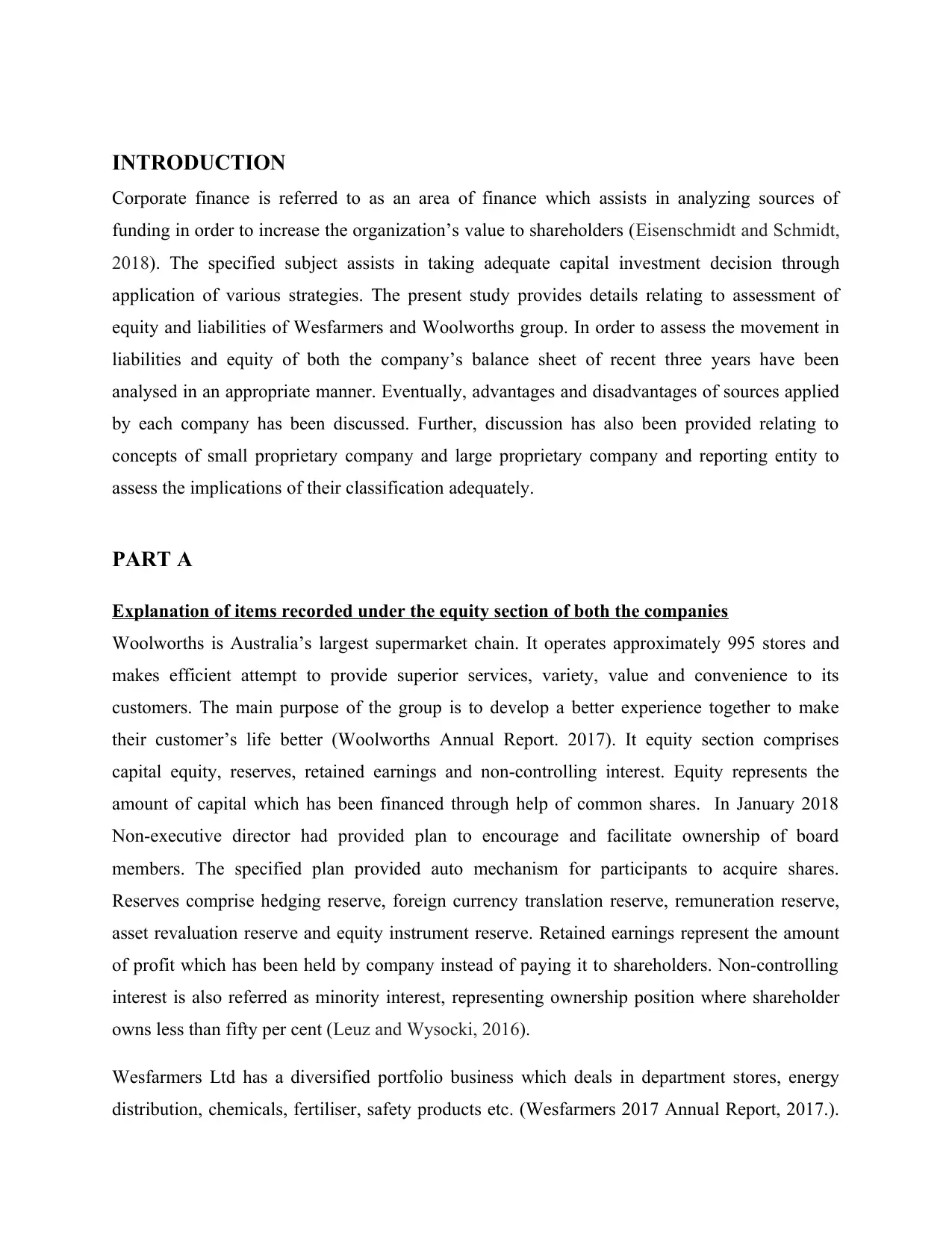
INTRODUCTION
Corporate finance is referred to as an area of finance which assists in analyzing sources of
funding in order to increase the organization’s value to shareholders (Eisenschmidt and Schmidt,
2018). The specified subject assists in taking adequate capital investment decision through
application of various strategies. The present study provides details relating to assessment of
equity and liabilities of Wesfarmers and Woolworths group. In order to assess the movement in
liabilities and equity of both the company’s balance sheet of recent three years have been
analysed in an appropriate manner. Eventually, advantages and disadvantages of sources applied
by each company has been discussed. Further, discussion has also been provided relating to
concepts of small proprietary company and large proprietary company and reporting entity to
assess the implications of their classification adequately.
PART A
Explanation of items recorded under the equity section of both the companies
Woolworths is Australia’s largest supermarket chain. It operates approximately 995 stores and
makes efficient attempt to provide superior services, variety, value and convenience to its
customers. The main purpose of the group is to develop a better experience together to make
their customer’s life better (Woolworths Annual Report. 2017). It equity section comprises
capital equity, reserves, retained earnings and non-controlling interest. Equity represents the
amount of capital which has been financed through help of common shares. In January 2018
Non-executive director had provided plan to encourage and facilitate ownership of board
members. The specified plan provided auto mechanism for participants to acquire shares.
Reserves comprise hedging reserve, foreign currency translation reserve, remuneration reserve,
asset revaluation reserve and equity instrument reserve. Retained earnings represent the amount
of profit which has been held by company instead of paying it to shareholders. Non-controlling
interest is also referred as minority interest, representing ownership position where shareholder
owns less than fifty per cent (Leuz and Wysocki, 2016).
Wesfarmers Ltd has a diversified portfolio business which deals in department stores, energy
distribution, chemicals, fertiliser, safety products etc. (Wesfarmers 2017 Annual Report, 2017.).
Corporate finance is referred to as an area of finance which assists in analyzing sources of
funding in order to increase the organization’s value to shareholders (Eisenschmidt and Schmidt,
2018). The specified subject assists in taking adequate capital investment decision through
application of various strategies. The present study provides details relating to assessment of
equity and liabilities of Wesfarmers and Woolworths group. In order to assess the movement in
liabilities and equity of both the company’s balance sheet of recent three years have been
analysed in an appropriate manner. Eventually, advantages and disadvantages of sources applied
by each company has been discussed. Further, discussion has also been provided relating to
concepts of small proprietary company and large proprietary company and reporting entity to
assess the implications of their classification adequately.
PART A
Explanation of items recorded under the equity section of both the companies
Woolworths is Australia’s largest supermarket chain. It operates approximately 995 stores and
makes efficient attempt to provide superior services, variety, value and convenience to its
customers. The main purpose of the group is to develop a better experience together to make
their customer’s life better (Woolworths Annual Report. 2017). It equity section comprises
capital equity, reserves, retained earnings and non-controlling interest. Equity represents the
amount of capital which has been financed through help of common shares. In January 2018
Non-executive director had provided plan to encourage and facilitate ownership of board
members. The specified plan provided auto mechanism for participants to acquire shares.
Reserves comprise hedging reserve, foreign currency translation reserve, remuneration reserve,
asset revaluation reserve and equity instrument reserve. Retained earnings represent the amount
of profit which has been held by company instead of paying it to shareholders. Non-controlling
interest is also referred as minority interest, representing ownership position where shareholder
owns less than fifty per cent (Leuz and Wysocki, 2016).
Wesfarmers Ltd has a diversified portfolio business which deals in department stores, energy
distribution, chemicals, fertiliser, safety products etc. (Wesfarmers 2017 Annual Report, 2017.).
Paraphrase This Document
Need a fresh take? Get an instant paraphrase of this document with our AI Paraphraser
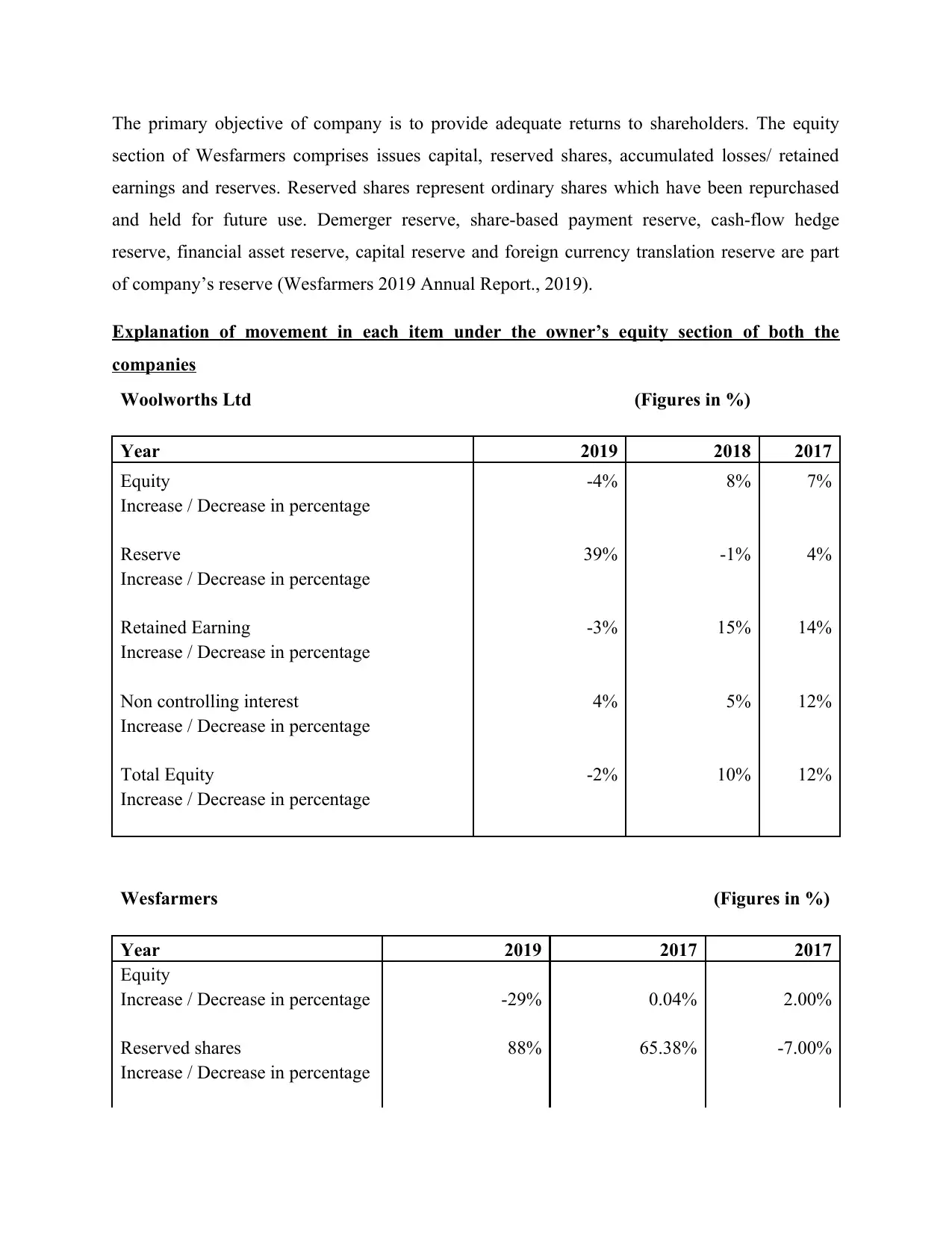
The primary objective of company is to provide adequate returns to shareholders. The equity
section of Wesfarmers comprises issues capital, reserved shares, accumulated losses/ retained
earnings and reserves. Reserved shares represent ordinary shares which have been repurchased
and held for future use. Demerger reserve, share-based payment reserve, cash-flow hedge
reserve, financial asset reserve, capital reserve and foreign currency translation reserve are part
of company’s reserve (Wesfarmers 2019 Annual Report., 2019).
Explanation of movement in each item under the owner’s equity section of both the
companies
Woolworths Ltd (Figures in %)
Year 2019 2018 2017
Equity -4% 8% 7%
Increase / Decrease in percentage
Reserve 39% -1% 4%
Increase / Decrease in percentage
Retained Earning -3% 15% 14%
Increase / Decrease in percentage
Non controlling interest 4% 5% 12%
Increase / Decrease in percentage
Total Equity -2% 10% 12%
Increase / Decrease in percentage
Wesfarmers (Figures in %)
Year 2019 2017 2017
Equity
Increase / Decrease in percentage -29% 0.04% 2.00%
Reserved shares 88% 65.38% -7.00%
Increase / Decrease in percentage
section of Wesfarmers comprises issues capital, reserved shares, accumulated losses/ retained
earnings and reserves. Reserved shares represent ordinary shares which have been repurchased
and held for future use. Demerger reserve, share-based payment reserve, cash-flow hedge
reserve, financial asset reserve, capital reserve and foreign currency translation reserve are part
of company’s reserve (Wesfarmers 2019 Annual Report., 2019).
Explanation of movement in each item under the owner’s equity section of both the
companies
Woolworths Ltd (Figures in %)
Year 2019 2018 2017
Equity -4% 8% 7%
Increase / Decrease in percentage
Reserve 39% -1% 4%
Increase / Decrease in percentage
Retained Earning -3% 15% 14%
Increase / Decrease in percentage
Non controlling interest 4% 5% 12%
Increase / Decrease in percentage
Total Equity -2% 10% 12%
Increase / Decrease in percentage
Wesfarmers (Figures in %)
Year 2019 2017 2017
Equity
Increase / Decrease in percentage -29% 0.04% 2.00%
Reserved shares 88% 65.38% -7.00%
Increase / Decrease in percentage
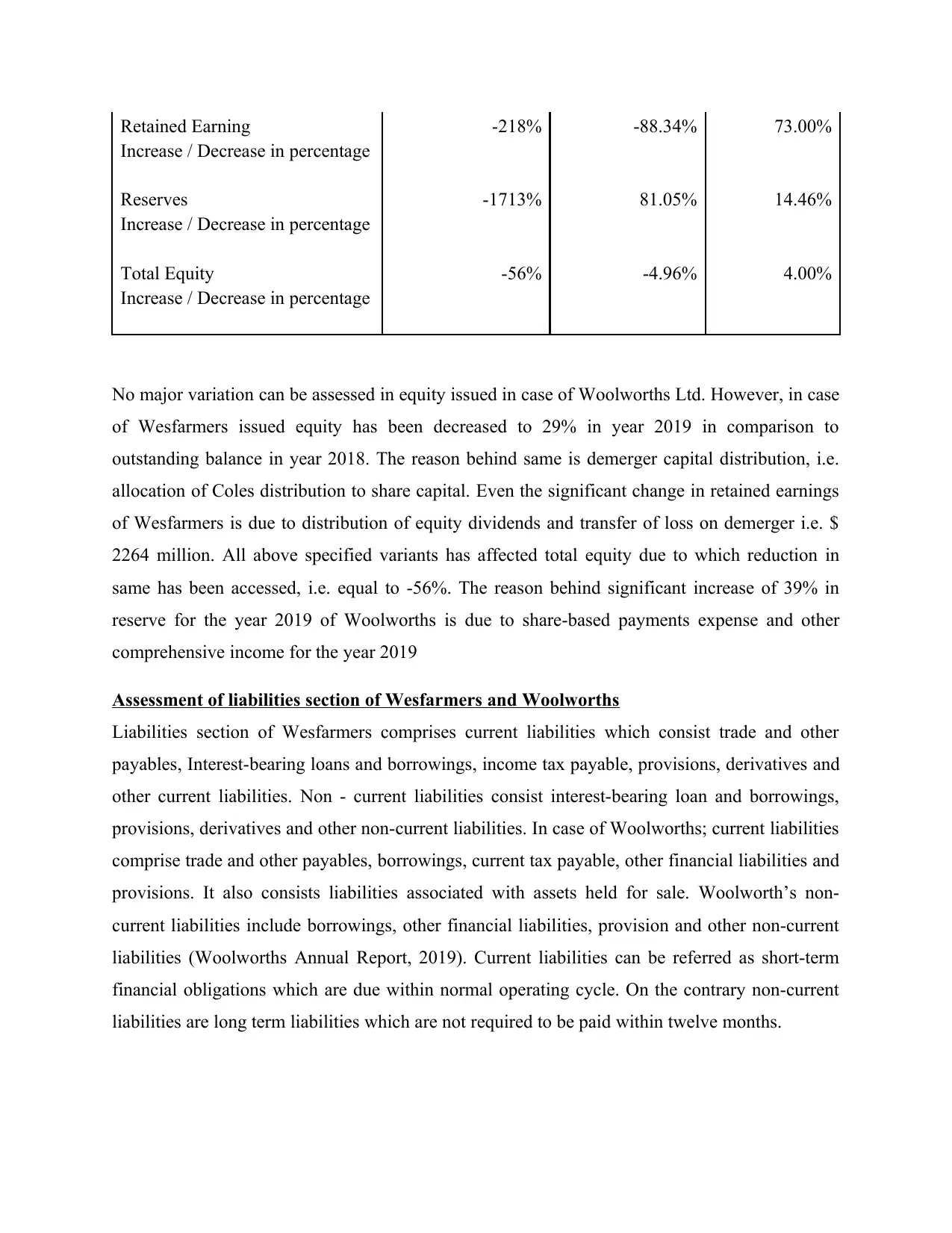
Retained Earning -218% -88.34% 73.00%
Increase / Decrease in percentage
Reserves -1713% 81.05% 14.46%
Increase / Decrease in percentage
Total Equity -56% -4.96% 4.00%
Increase / Decrease in percentage
No major variation can be assessed in equity issued in case of Woolworths Ltd. However, in case
of Wesfarmers issued equity has been decreased to 29% in year 2019 in comparison to
outstanding balance in year 2018. The reason behind same is demerger capital distribution, i.e.
allocation of Coles distribution to share capital. Even the significant change in retained earnings
of Wesfarmers is due to distribution of equity dividends and transfer of loss on demerger i.e. $
2264 million. All above specified variants has affected total equity due to which reduction in
same has been accessed, i.e. equal to -56%. The reason behind significant increase of 39% in
reserve for the year 2019 of Woolworths is due to share-based payments expense and other
comprehensive income for the year 2019
Assessment of liabilities section of Wesfarmers and Woolworths
Liabilities section of Wesfarmers comprises current liabilities which consist trade and other
payables, Interest-bearing loans and borrowings, income tax payable, provisions, derivatives and
other current liabilities. Non - current liabilities consist interest-bearing loan and borrowings,
provisions, derivatives and other non-current liabilities. In case of Woolworths; current liabilities
comprise trade and other payables, borrowings, current tax payable, other financial liabilities and
provisions. It also consists liabilities associated with assets held for sale. Woolworth’s non-
current liabilities include borrowings, other financial liabilities, provision and other non-current
liabilities (Woolworths Annual Report, 2019). Current liabilities can be referred as short-term
financial obligations which are due within normal operating cycle. On the contrary non-current
liabilities are long term liabilities which are not required to be paid within twelve months.
Increase / Decrease in percentage
Reserves -1713% 81.05% 14.46%
Increase / Decrease in percentage
Total Equity -56% -4.96% 4.00%
Increase / Decrease in percentage
No major variation can be assessed in equity issued in case of Woolworths Ltd. However, in case
of Wesfarmers issued equity has been decreased to 29% in year 2019 in comparison to
outstanding balance in year 2018. The reason behind same is demerger capital distribution, i.e.
allocation of Coles distribution to share capital. Even the significant change in retained earnings
of Wesfarmers is due to distribution of equity dividends and transfer of loss on demerger i.e. $
2264 million. All above specified variants has affected total equity due to which reduction in
same has been accessed, i.e. equal to -56%. The reason behind significant increase of 39% in
reserve for the year 2019 of Woolworths is due to share-based payments expense and other
comprehensive income for the year 2019
Assessment of liabilities section of Wesfarmers and Woolworths
Liabilities section of Wesfarmers comprises current liabilities which consist trade and other
payables, Interest-bearing loans and borrowings, income tax payable, provisions, derivatives and
other current liabilities. Non - current liabilities consist interest-bearing loan and borrowings,
provisions, derivatives and other non-current liabilities. In case of Woolworths; current liabilities
comprise trade and other payables, borrowings, current tax payable, other financial liabilities and
provisions. It also consists liabilities associated with assets held for sale. Woolworth’s non-
current liabilities include borrowings, other financial liabilities, provision and other non-current
liabilities (Woolworths Annual Report, 2019). Current liabilities can be referred as short-term
financial obligations which are due within normal operating cycle. On the contrary non-current
liabilities are long term liabilities which are not required to be paid within twelve months.
⊘ This is a preview!⊘
Do you want full access?
Subscribe today to unlock all pages.

Trusted by 1+ million students worldwide
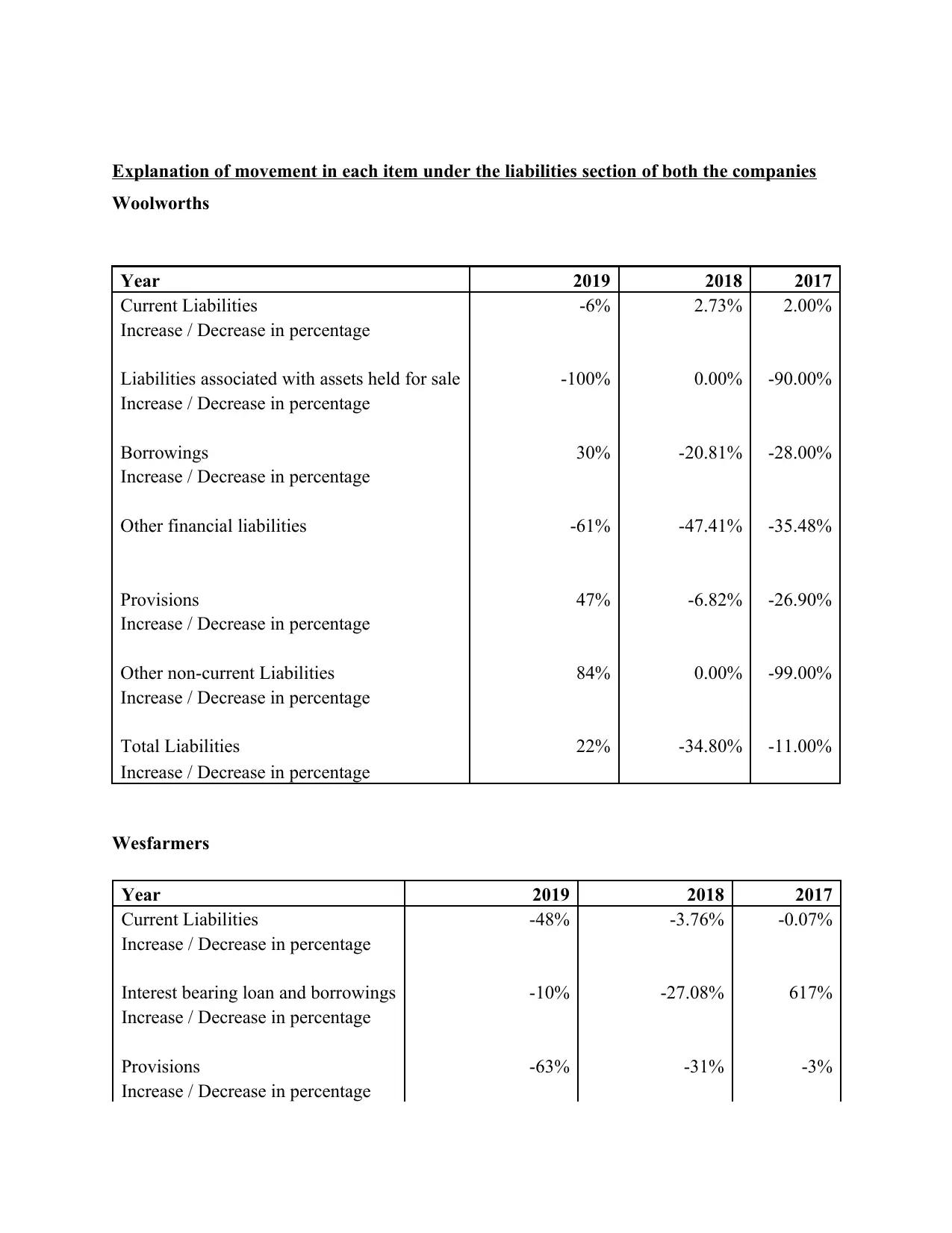
Explanation of movement in each item under the liabilities section of both the companies
Woolworths
Year 2019 2018 2017
Current Liabilities -6% 2.73% 2.00%
Increase / Decrease in percentage
Liabilities associated with assets held for sale -100% 0.00% -90.00%
Increase / Decrease in percentage
Borrowings 30% -20.81% -28.00%
Increase / Decrease in percentage
Other financial liabilities -61% -47.41% -35.48%
Provisions 47% -6.82% -26.90%
Increase / Decrease in percentage
Other non-current Liabilities 84% 0.00% -99.00%
Increase / Decrease in percentage
Total Liabilities 22% -34.80% -11.00%
Increase / Decrease in percentage
Wesfarmers
Year 2019 2018 2017
Current Liabilities -48% -3.76% -0.07%
Increase / Decrease in percentage
Interest bearing loan and borrowings -10% -27.08% 617%
Increase / Decrease in percentage
Provisions -63% -31% -3%
Increase / Decrease in percentage
Woolworths
Year 2019 2018 2017
Current Liabilities -6% 2.73% 2.00%
Increase / Decrease in percentage
Liabilities associated with assets held for sale -100% 0.00% -90.00%
Increase / Decrease in percentage
Borrowings 30% -20.81% -28.00%
Increase / Decrease in percentage
Other financial liabilities -61% -47.41% -35.48%
Provisions 47% -6.82% -26.90%
Increase / Decrease in percentage
Other non-current Liabilities 84% 0.00% -99.00%
Increase / Decrease in percentage
Total Liabilities 22% -34.80% -11.00%
Increase / Decrease in percentage
Wesfarmers
Year 2019 2018 2017
Current Liabilities -48% -3.76% -0.07%
Increase / Decrease in percentage
Interest bearing loan and borrowings -10% -27.08% 617%
Increase / Decrease in percentage
Provisions -63% -31% -3%
Increase / Decrease in percentage
Paraphrase This Document
Need a fresh take? Get an instant paraphrase of this document with our AI Paraphraser
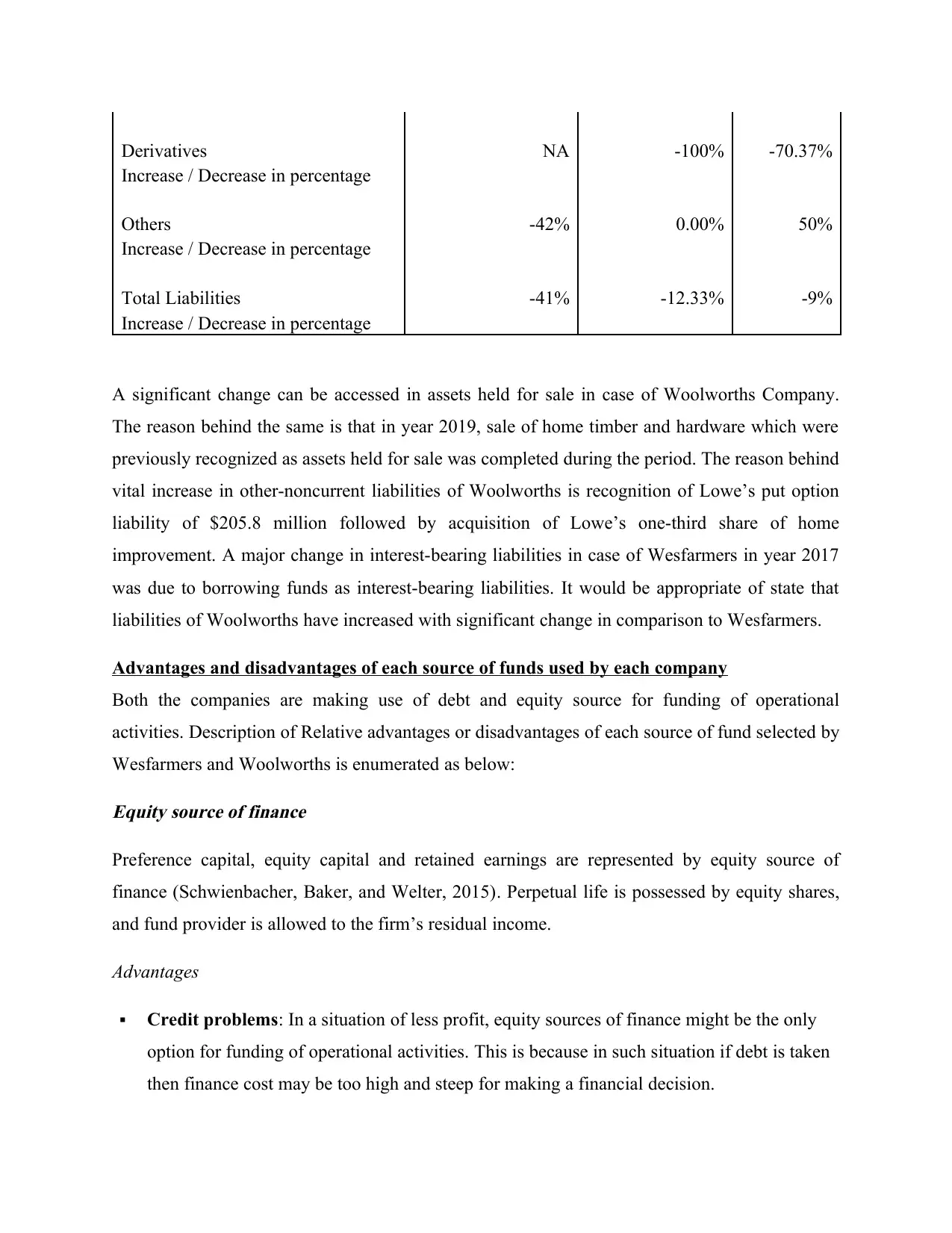
Derivatives NA -100% -70.37%
Increase / Decrease in percentage
Others -42% 0.00% 50%
Increase / Decrease in percentage
Total Liabilities -41% -12.33% -9%
Increase / Decrease in percentage
A significant change can be accessed in assets held for sale in case of Woolworths Company.
The reason behind the same is that in year 2019, sale of home timber and hardware which were
previously recognized as assets held for sale was completed during the period. The reason behind
vital increase in other-noncurrent liabilities of Woolworths is recognition of Lowe’s put option
liability of $205.8 million followed by acquisition of Lowe’s one-third share of home
improvement. A major change in interest-bearing liabilities in case of Wesfarmers in year 2017
was due to borrowing funds as interest-bearing liabilities. It would be appropriate of state that
liabilities of Woolworths have increased with significant change in comparison to Wesfarmers.
Advantages and disadvantages of each source of funds used by each company
Both the companies are making use of debt and equity source for funding of operational
activities. Description of Relative advantages or disadvantages of each source of fund selected by
Wesfarmers and Woolworths is enumerated as below:
Equity source of finance
Preference capital, equity capital and retained earnings are represented by equity source of
finance (Schwienbacher, Baker, and Welter, 2015). Perpetual life is possessed by equity shares,
and fund provider is allowed to the firm’s residual income.
Advantages
Credit problems: In a situation of less profit, equity sources of finance might be the only
option for funding of operational activities. This is because in such situation if debt is taken
then finance cost may be too high and steep for making a financial decision.
Increase / Decrease in percentage
Others -42% 0.00% 50%
Increase / Decrease in percentage
Total Liabilities -41% -12.33% -9%
Increase / Decrease in percentage
A significant change can be accessed in assets held for sale in case of Woolworths Company.
The reason behind the same is that in year 2019, sale of home timber and hardware which were
previously recognized as assets held for sale was completed during the period. The reason behind
vital increase in other-noncurrent liabilities of Woolworths is recognition of Lowe’s put option
liability of $205.8 million followed by acquisition of Lowe’s one-third share of home
improvement. A major change in interest-bearing liabilities in case of Wesfarmers in year 2017
was due to borrowing funds as interest-bearing liabilities. It would be appropriate of state that
liabilities of Woolworths have increased with significant change in comparison to Wesfarmers.
Advantages and disadvantages of each source of funds used by each company
Both the companies are making use of debt and equity source for funding of operational
activities. Description of Relative advantages or disadvantages of each source of fund selected by
Wesfarmers and Woolworths is enumerated as below:
Equity source of finance
Preference capital, equity capital and retained earnings are represented by equity source of
finance (Schwienbacher, Baker, and Welter, 2015). Perpetual life is possessed by equity shares,
and fund provider is allowed to the firm’s residual income.
Advantages
Credit problems: In a situation of less profit, equity sources of finance might be the only
option for funding of operational activities. This is because in such situation if debt is taken
then finance cost may be too high and steep for making a financial decision.
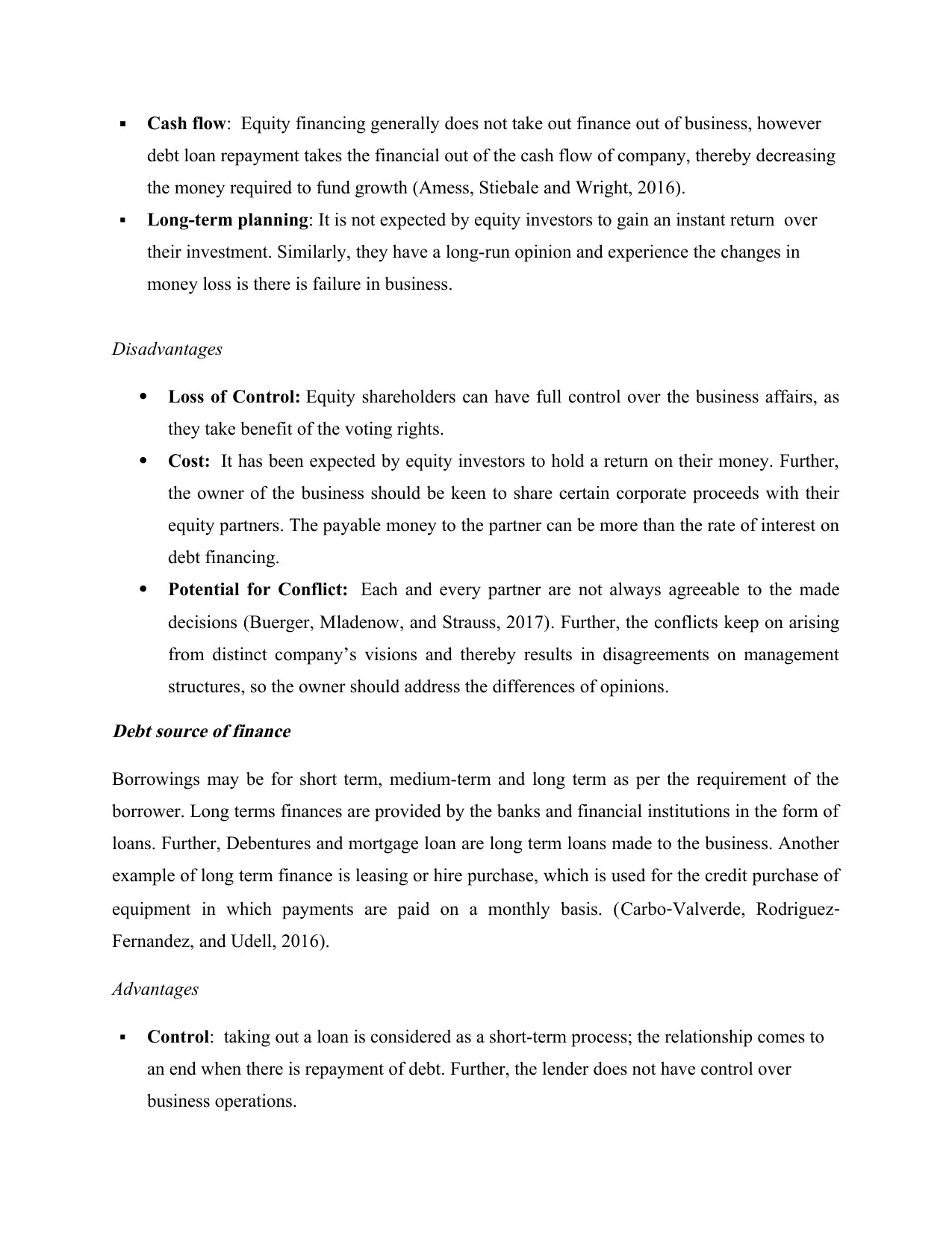
Cash flow: Equity financing generally does not take out finance out of business, however
debt loan repayment takes the financial out of the cash flow of company, thereby decreasing
the money required to fund growth (Amess, Stiebale and Wright, 2016).
Long-term planning: It is not expected by equity investors to gain an instant return over
their investment. Similarly, they have a long-run opinion and experience the changes in
money loss is there is failure in business.
Disadvantages
Loss of Control: Equity shareholders can have full control over the business affairs, as
they take benefit of the voting rights.
Cost: It has been expected by equity investors to hold a return on their money. Further,
the owner of the business should be keen to share certain corporate proceeds with their
equity partners. The payable money to the partner can be more than the rate of interest on
debt financing.
Potential for Conflict: Each and every partner are not always agreeable to the made
decisions (Buerger, Mladenow, and Strauss, 2017). Further, the conflicts keep on arising
from distinct company’s visions and thereby results in disagreements on management
structures, so the owner should address the differences of opinions.
Debt source of finance
Borrowings may be for short term, medium-term and long term as per the requirement of the
borrower. Long terms finances are provided by the banks and financial institutions in the form of
loans. Further, Debentures and mortgage loan are long term loans made to the business. Another
example of long term finance is leasing or hire purchase, which is used for the credit purchase of
equipment in which payments are paid on a monthly basis. (Carbo‐Valverde, Rodriguez‐
Fernandez, and Udell, 2016).
Advantages
Control: taking out a loan is considered as a short-term process; the relationship comes to
an end when there is repayment of debt. Further, the lender does not have control over
business operations.
debt loan repayment takes the financial out of the cash flow of company, thereby decreasing
the money required to fund growth (Amess, Stiebale and Wright, 2016).
Long-term planning: It is not expected by equity investors to gain an instant return over
their investment. Similarly, they have a long-run opinion and experience the changes in
money loss is there is failure in business.
Disadvantages
Loss of Control: Equity shareholders can have full control over the business affairs, as
they take benefit of the voting rights.
Cost: It has been expected by equity investors to hold a return on their money. Further,
the owner of the business should be keen to share certain corporate proceeds with their
equity partners. The payable money to the partner can be more than the rate of interest on
debt financing.
Potential for Conflict: Each and every partner are not always agreeable to the made
decisions (Buerger, Mladenow, and Strauss, 2017). Further, the conflicts keep on arising
from distinct company’s visions and thereby results in disagreements on management
structures, so the owner should address the differences of opinions.
Debt source of finance
Borrowings may be for short term, medium-term and long term as per the requirement of the
borrower. Long terms finances are provided by the banks and financial institutions in the form of
loans. Further, Debentures and mortgage loan are long term loans made to the business. Another
example of long term finance is leasing or hire purchase, which is used for the credit purchase of
equipment in which payments are paid on a monthly basis. (Carbo‐Valverde, Rodriguez‐
Fernandez, and Udell, 2016).
Advantages
Control: taking out a loan is considered as a short-term process; the relationship comes to
an end when there is repayment of debt. Further, the lender does not have control over
business operations.
⊘ This is a preview!⊘
Do you want full access?
Subscribe today to unlock all pages.

Trusted by 1+ million students worldwide
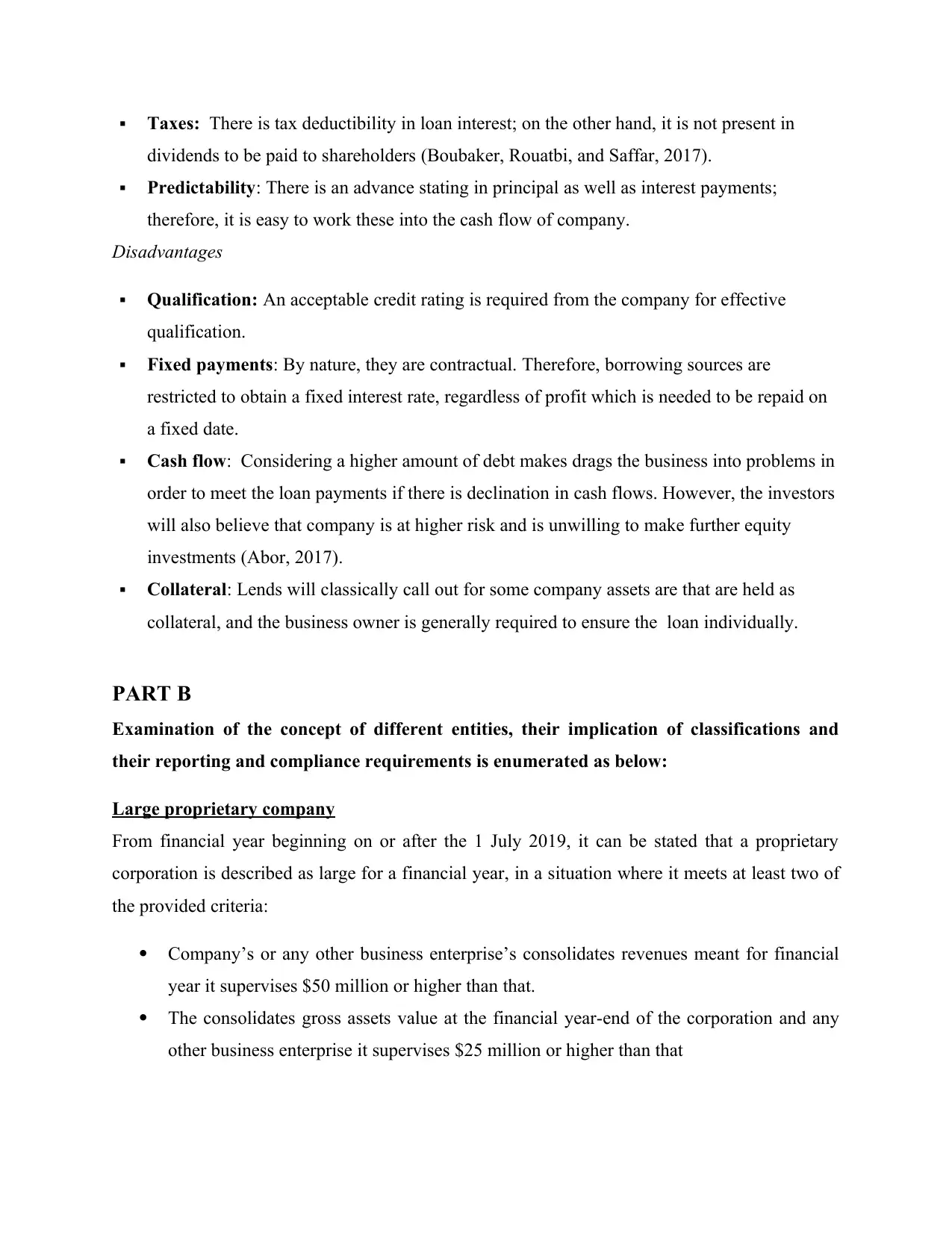
Taxes: There is tax deductibility in loan interest; on the other hand, it is not present in
dividends to be paid to shareholders (Boubaker, Rouatbi, and Saffar, 2017).
Predictability: There is an advance stating in principal as well as interest payments;
therefore, it is easy to work these into the cash flow of company.
Disadvantages
Qualification: An acceptable credit rating is required from the company for effective
qualification.
Fixed payments: By nature, they are contractual. Therefore, borrowing sources are
restricted to obtain a fixed interest rate, regardless of profit which is needed to be repaid on
a fixed date.
Cash flow: Considering a higher amount of debt makes drags the business into problems in
order to meet the loan payments if there is declination in cash flows. However, the investors
will also believe that company is at higher risk and is unwilling to make further equity
investments (Abor, 2017).
Collateral: Lends will classically call out for some company assets are that are held as
collateral, and the business owner is generally required to ensure the loan individually.
PART B
Examination of the concept of different entities, their implication of classifications and
their reporting and compliance requirements is enumerated as below:
Large proprietary company
From financial year beginning on or after the 1 July 2019, it can be stated that a proprietary
corporation is described as large for a financial year, in a situation where it meets at least two of
the provided criteria:
Company’s or any other business enterprise’s consolidates revenues meant for financial
year it supervises $50 million or higher than that.
The consolidates gross assets value at the financial year-end of the corporation and any
other business enterprise it supervises $25 million or higher than that
dividends to be paid to shareholders (Boubaker, Rouatbi, and Saffar, 2017).
Predictability: There is an advance stating in principal as well as interest payments;
therefore, it is easy to work these into the cash flow of company.
Disadvantages
Qualification: An acceptable credit rating is required from the company for effective
qualification.
Fixed payments: By nature, they are contractual. Therefore, borrowing sources are
restricted to obtain a fixed interest rate, regardless of profit which is needed to be repaid on
a fixed date.
Cash flow: Considering a higher amount of debt makes drags the business into problems in
order to meet the loan payments if there is declination in cash flows. However, the investors
will also believe that company is at higher risk and is unwilling to make further equity
investments (Abor, 2017).
Collateral: Lends will classically call out for some company assets are that are held as
collateral, and the business owner is generally required to ensure the loan individually.
PART B
Examination of the concept of different entities, their implication of classifications and
their reporting and compliance requirements is enumerated as below:
Large proprietary company
From financial year beginning on or after the 1 July 2019, it can be stated that a proprietary
corporation is described as large for a financial year, in a situation where it meets at least two of
the provided criteria:
Company’s or any other business enterprise’s consolidates revenues meant for financial
year it supervises $50 million or higher than that.
The consolidates gross assets value at the financial year-end of the corporation and any
other business enterprise it supervises $25 million or higher than that
Paraphrase This Document
Need a fresh take? Get an instant paraphrase of this document with our AI Paraphraser
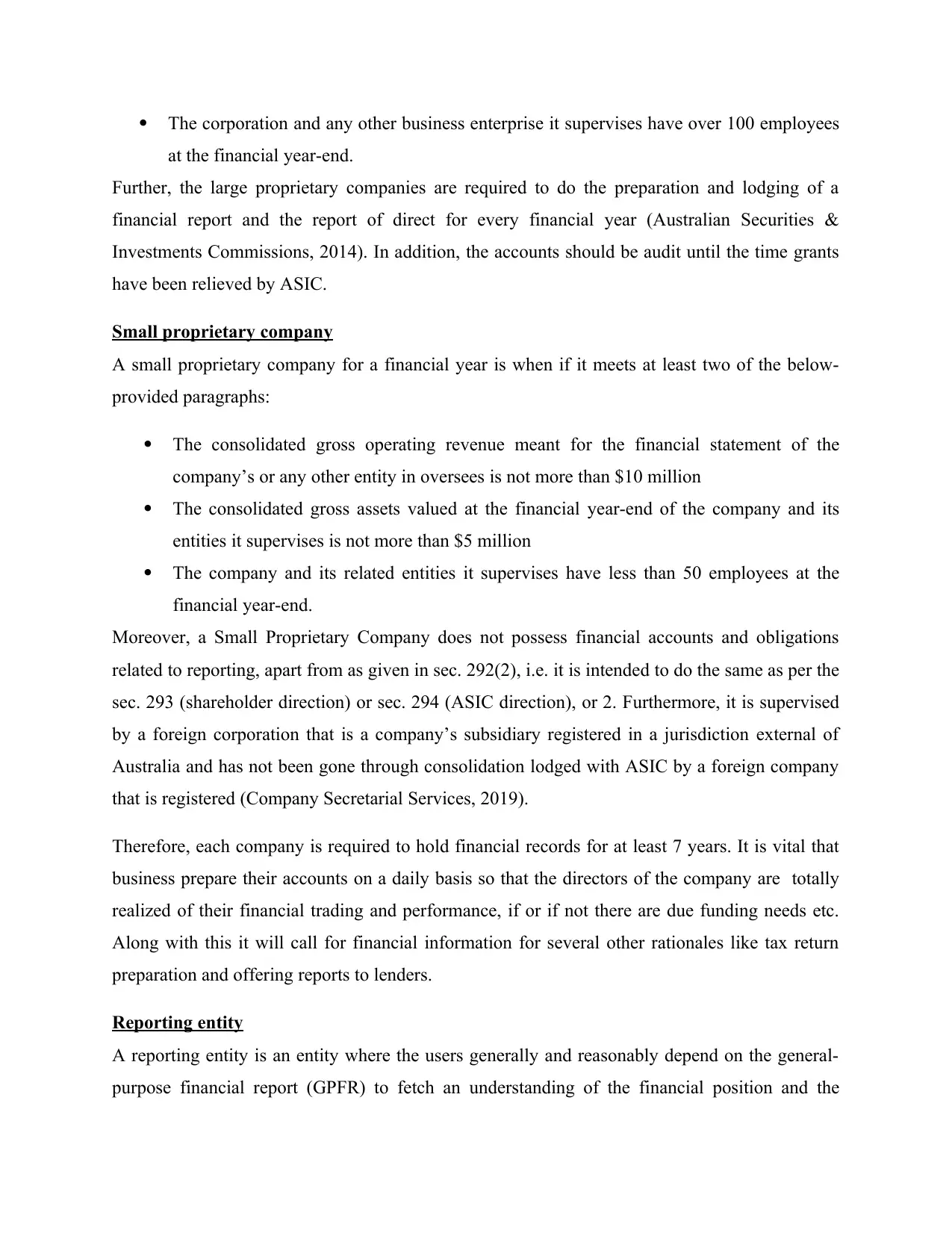
The corporation and any other business enterprise it supervises have over 100 employees
at the financial year-end.
Further, the large proprietary companies are required to do the preparation and lodging of a
financial report and the report of direct for every financial year (Australian Securities &
Investments Commissions, 2014). In addition, the accounts should be audit until the time grants
have been relieved by ASIC.
Small proprietary company
A small proprietary company for a financial year is when if it meets at least two of the below-
provided paragraphs:
The consolidated gross operating revenue meant for the financial statement of the
company’s or any other entity in oversees is not more than $10 million
The consolidated gross assets valued at the financial year-end of the company and its
entities it supervises is not more than $5 million
The company and its related entities it supervises have less than 50 employees at the
financial year-end.
Moreover, a Small Proprietary Company does not possess financial accounts and obligations
related to reporting, apart from as given in sec. 292(2), i.e. it is intended to do the same as per the
sec. 293 (shareholder direction) or sec. 294 (ASIC direction), or 2. Furthermore, it is supervised
by a foreign corporation that is a company’s subsidiary registered in a jurisdiction external of
Australia and has not been gone through consolidation lodged with ASIC by a foreign company
that is registered (Company Secretarial Services, 2019).
Therefore, each company is required to hold financial records for at least 7 years. It is vital that
business prepare their accounts on a daily basis so that the directors of the company are totally
realized of their financial trading and performance, if or if not there are due funding needs etc.
Along with this it will call for financial information for several other rationales like tax return
preparation and offering reports to lenders.
Reporting entity
A reporting entity is an entity where the users generally and reasonably depend on the general-
purpose financial report (GPFR) to fetch an understanding of the financial position and the
at the financial year-end.
Further, the large proprietary companies are required to do the preparation and lodging of a
financial report and the report of direct for every financial year (Australian Securities &
Investments Commissions, 2014). In addition, the accounts should be audit until the time grants
have been relieved by ASIC.
Small proprietary company
A small proprietary company for a financial year is when if it meets at least two of the below-
provided paragraphs:
The consolidated gross operating revenue meant for the financial statement of the
company’s or any other entity in oversees is not more than $10 million
The consolidated gross assets valued at the financial year-end of the company and its
entities it supervises is not more than $5 million
The company and its related entities it supervises have less than 50 employees at the
financial year-end.
Moreover, a Small Proprietary Company does not possess financial accounts and obligations
related to reporting, apart from as given in sec. 292(2), i.e. it is intended to do the same as per the
sec. 293 (shareholder direction) or sec. 294 (ASIC direction), or 2. Furthermore, it is supervised
by a foreign corporation that is a company’s subsidiary registered in a jurisdiction external of
Australia and has not been gone through consolidation lodged with ASIC by a foreign company
that is registered (Company Secretarial Services, 2019).
Therefore, each company is required to hold financial records for at least 7 years. It is vital that
business prepare their accounts on a daily basis so that the directors of the company are totally
realized of their financial trading and performance, if or if not there are due funding needs etc.
Along with this it will call for financial information for several other rationales like tax return
preparation and offering reports to lenders.
Reporting entity
A reporting entity is an entity where the users generally and reasonably depend on the general-
purpose financial report (GPFR) to fetch an understanding of the financial position and the
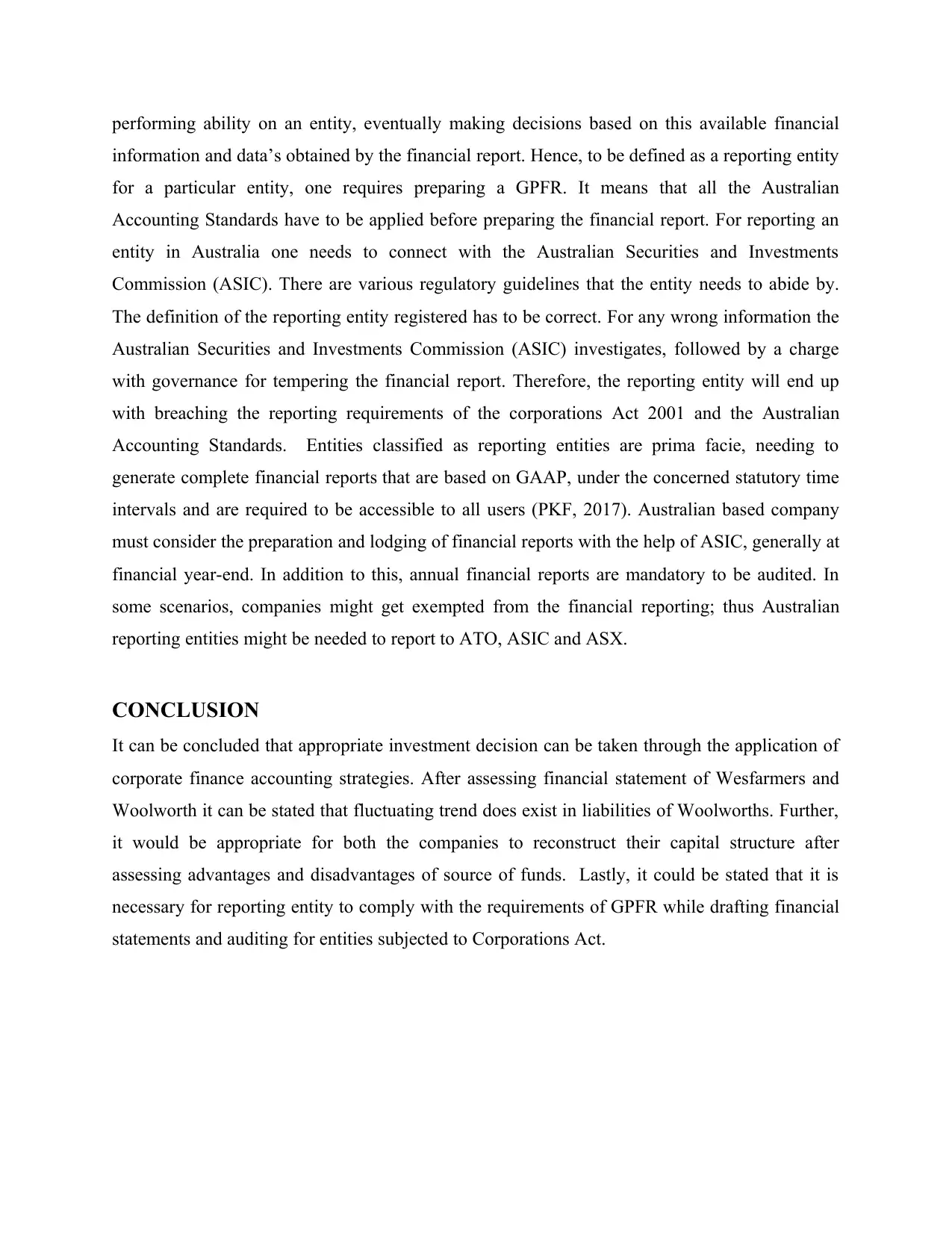
performing ability on an entity, eventually making decisions based on this available financial
information and data’s obtained by the financial report. Hence, to be defined as a reporting entity
for a particular entity, one requires preparing a GPFR. It means that all the Australian
Accounting Standards have to be applied before preparing the financial report. For reporting an
entity in Australia one needs to connect with the Australian Securities and Investments
Commission (ASIC). There are various regulatory guidelines that the entity needs to abide by.
The definition of the reporting entity registered has to be correct. For any wrong information the
Australian Securities and Investments Commission (ASIC) investigates, followed by a charge
with governance for tempering the financial report. Therefore, the reporting entity will end up
with breaching the reporting requirements of the corporations Act 2001 and the Australian
Accounting Standards. Entities classified as reporting entities are prima facie, needing to
generate complete financial reports that are based on GAAP, under the concerned statutory time
intervals and are required to be accessible to all users (PKF, 2017). Australian based company
must consider the preparation and lodging of financial reports with the help of ASIC, generally at
financial year-end. In addition to this, annual financial reports are mandatory to be audited. In
some scenarios, companies might get exempted from the financial reporting; thus Australian
reporting entities might be needed to report to ATO, ASIC and ASX.
CONCLUSION
It can be concluded that appropriate investment decision can be taken through the application of
corporate finance accounting strategies. After assessing financial statement of Wesfarmers and
Woolworth it can be stated that fluctuating trend does exist in liabilities of Woolworths. Further,
it would be appropriate for both the companies to reconstruct their capital structure after
assessing advantages and disadvantages of source of funds. Lastly, it could be stated that it is
necessary for reporting entity to comply with the requirements of GPFR while drafting financial
statements and auditing for entities subjected to Corporations Act.
information and data’s obtained by the financial report. Hence, to be defined as a reporting entity
for a particular entity, one requires preparing a GPFR. It means that all the Australian
Accounting Standards have to be applied before preparing the financial report. For reporting an
entity in Australia one needs to connect with the Australian Securities and Investments
Commission (ASIC). There are various regulatory guidelines that the entity needs to abide by.
The definition of the reporting entity registered has to be correct. For any wrong information the
Australian Securities and Investments Commission (ASIC) investigates, followed by a charge
with governance for tempering the financial report. Therefore, the reporting entity will end up
with breaching the reporting requirements of the corporations Act 2001 and the Australian
Accounting Standards. Entities classified as reporting entities are prima facie, needing to
generate complete financial reports that are based on GAAP, under the concerned statutory time
intervals and are required to be accessible to all users (PKF, 2017). Australian based company
must consider the preparation and lodging of financial reports with the help of ASIC, generally at
financial year-end. In addition to this, annual financial reports are mandatory to be audited. In
some scenarios, companies might get exempted from the financial reporting; thus Australian
reporting entities might be needed to report to ATO, ASIC and ASX.
CONCLUSION
It can be concluded that appropriate investment decision can be taken through the application of
corporate finance accounting strategies. After assessing financial statement of Wesfarmers and
Woolworth it can be stated that fluctuating trend does exist in liabilities of Woolworths. Further,
it would be appropriate for both the companies to reconstruct their capital structure after
assessing advantages and disadvantages of source of funds. Lastly, it could be stated that it is
necessary for reporting entity to comply with the requirements of GPFR while drafting financial
statements and auditing for entities subjected to Corporations Act.
⊘ This is a preview!⊘
Do you want full access?
Subscribe today to unlock all pages.

Trusted by 1+ million students worldwide
1 out of 19
Related Documents
Your All-in-One AI-Powered Toolkit for Academic Success.
+13062052269
info@desklib.com
Available 24*7 on WhatsApp / Email
![[object Object]](/_next/static/media/star-bottom.7253800d.svg)
Unlock your academic potential
Copyright © 2020–2025 A2Z Services. All Rights Reserved. Developed and managed by ZUCOL.




